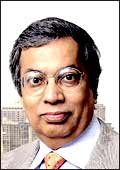 |
|
Buddhadeb: Seeking a solution
|
 |
| HPL's Chatterjee: In a fix |
First
the consolation: Haldia Petrochemicals (HPL) is still in the black,
but there are ominous signs; its pre-tax profit has shrunk nearly
54 per cent (excluding other income and factoring in the drop
in interest) despite a 22 per cent rise in turnover. The implication:
margins are plunging. And 17 key executives have left the company
over the last 8-9 months. The common factor behind all these:
the wrangle between co-promoters Purnendu Chatterjee and the West
Bengal government over management control of the company. It is,
perhaps, the only blotch of red ink in West Bengal Chief Minister
Buddhadeb Bhattacharjee's otherwise enviable scorecard. Not surprisingly,
Bhattacharjee's instructions to his team of troubleshooters: sort
out HPL's problems ASAP.
Chatterjee, who owns a clear majority in
HPL, wants a free hand to guide its destiny. But the government,
which has a sizable, albeit minority stake, is unwilling to grant
him that leeway. Commerce and Industries Minister Nirupam Sen,
however, strikes a conciliatory note. "We're ready to sell
our stake at a mutually agreed price," he says. The state
wants Rs 28.90 per share, but The Chatterjee Group (TCG) is willing
to pay only what is fixed by an independent valuer as per the
original promoters' agreement.
Another sticking point is the shareholding
pattern in the company. According to TCG sources, it holds 59.9
per cent stake, the West Bengal Industrial Development Corporation
(WBIDC) owns 36.9 per cent and the Tata Group the residual 3.2
per cent. However, if the state's controversial issue of shares
to IOC, amounting to 9.6 per cent of HPL's paid-up capital, is
factored in, then TCG's stake will fall to 54 per cent, WBIDC's
to 33 per cent and the Tata Group's to 2.8 per cent. If negotiations
fail, it will need judicial intervention.
The HPL management, meanwhile, denies that
this dispute is responsible for its declining performance (see
The Figures Say It All). "The fall in profits is a result
of a worldwide rise in naphtha prices. It has nothing to do with
the so-called crisis over management control," says Swapan
Bhowmik, Managing Director, HPL. This argument looks a little
disingenuous. The price of naphtha, HPL's main raw material, has
risen about 40 per cent from Rs 18,000 per tonne to Rs 25,000
per tonne, but higher realisations from polymers (up 8 per cent)
and chemicals (up 32 per cent), HPL's two mainstay products, have
nearly offset the input price hike. Interest costs have also come
down by Rs 45 crore, cushioning margins further. Rising naphtha
prices are, therefore, responsible for only a small portion of
the profit fall.
No such pat excuses can explain the sudden
departure of 17 managers who formed the core of the group that
turned around HPL three years ago. Government officials admit
that their exit has stalled HPL's Rs 650-crore programme to expand
the capacity of its naptha cracker from 5.3 lakh tonne per annum
to 6.7 lakh tonne per annum. Bhowmik, however, denies this. "Our
expansion programme is proceeding according to plan and will be
commissioned by the last quarter of next year," he says.
Chatterjee himself refuses to comment on
any of the issues on the grounds that these are being adjudicated
upon by the Company Law Board. But he has also kept Track II communication
channels with the government open. But with so many visible and
invisible cross-currents at play here, it will take a while to
sort out this imbroglio.
|





